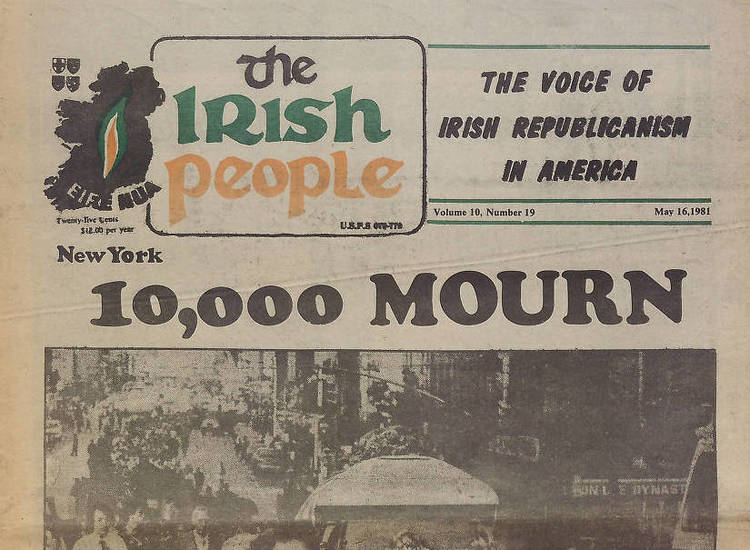Bear jpg
A Russian TU-95 “Bear” bomber
By Ray O’Hanlon
rohanlon@irishecho.com
The story almost had an air of routine about it.
The report, compiled by the Press Association and carried by British media outlets, stated that two Typhoon fighter jets were launched from RAF Lossiemouth to intercept Russian bombers heading towards the United Kingdom.
The Russian “Bear” aircraft were escorted away from Britain's area of interest, but at no stage crossed into UK sovereign airspace, the report stated.
The incident was, according to the report, the latest in a string of approaches to Britain by Russian planes and ships.
What the report left out was that Ireland, and Irish air space, had also been approached in the same string of high altitude intrusions.
The Lossiemouth scramble took place on May 14th last.
It was not the first such action this year, and it has been repeated in the weeks since.
Indeed, so frequent are the “incursions” that the Cold War-era movie “The Russians Are Coming” might well be due for a sequel.
And those Russians?
RUMBLES FROM THE NORTH
They come rumbling out of the north, from the skies between the Hebrides and Iceland, flying at 27,000 feet, in some instances with Ireland way down below and off to the larboard.
This is the Wild Atlantic Way, Russian Style, and other than firing off words of protest there is nothing that the Irish government and defense forces can do to deter what is considered a real hazard to civil aviation.
Back in January, well before the May Lossiemouth scramble, RAF fighters had taken to the air after a pair of Russian TU-95 “Bears” had raised the trip around the bay concept to a new level.
They appeared on British radars as they flew in an arc that took them on a flight path off Ireland’s west coast. Subsequent reports stated that their transponders were switched off.
In contrast to civilian airliners, the Russians were not making it easy for other aircraft in the vicinity to be aware of their presence.
The RAF knew, and duly sent up its Typhoons.
The bears looped around Ireland’s south coast and headed for the English Channel with the British fighters as close company.
Nobody panicked or fired a shot. Nobody was hurt, though Irish pride was somewhat dented.
The Bears had not penetrated sovereign airspace, but they had crossed through Irish controlled airspace, a much larger area in which civil aviation is the responsibility of the Republic’s air traffic control system.
One Irish politician, Fianna Fáil’s Transport Spokesperson Timmy Dooley, was incensed.
Dooley demanded that the government make immediate representations to Moscow.
He also called for a probe into reports that the British military authorities had not informed Irish civil aviation authorities that they had unleashed their Typhoons into air space under Irish control.
As far as Dooley was concerned, there was little to choose between Russian bombers and British fighters.
Ireland’s location, he said, meant that the Republic had some of the busiest airspace in Europe to look after with almost all transatlantic flights passing overhead.
The Russian and British unauthorized entry into Irish airspace had posed a threat, not only to Irish air passengers, but to thousands of people flying from Europe to the United States.
“These manoeuvers,” he said, “were not sanctioned by the Irish Aviation Authority and had put Irish air traffic controllers in the invidious position of not being able to carry out their duties effectively. This should not be tolerated.”
Dooley’s anger with the Russians had merit, and it was widely shared.
His anger over the British reaction was not likely to provoke as much sympathy.
That’s because his own party, during a period when it was in government, let slip that the Republic of Ireland was, de facto, under the protective wing of the Royal Air Force when it came to the defense of Irish skies.
This came to light after 9/11 when then, Fianna Fáil defense minister, Michael Smith, let slip in the Dáil that the RAF would come to Ireland’s aid if there was a 9/11-like incident over Ireland.
Smith’s statement was exclusively reported the following day on page 3 of the Irish Independent, but given the torrent of sobering news at the time, the story did not attract very much attention.
9/11 had been a wake-up call for governments everywhere, the Irish included.
WHAT DO WE NEED?
After the attack on America, then Taoiseach Bertie Ahern summoned Irish defense chiefs and asked a question.
What was needed to defend Irish territory and air space against terrorist attack?
Ahern was told "a squadron of F-16s.”
The General Dynamics F-16 “Fighting Falcon” is an attack fighter and interceptor that operates in America’s defense around the globe.
It’s an expensive piece of machinery; too expensive, it turned out, even for the emerging Celtic Tiger.
Said Don Lavery, an Irish journalist who specializes in defense issues: “Ireland, unlike Sweden, Switzerland and Austria, has never taken defense or neutrality seriously. Partly that is because defense is expensive and that means spending big bucks. But the first priority of any government should be to defend their people. In that regard we have failed miserably.”
Not that the Irish government at the time did nothing. But what was done was by far the cheaper option.
According to Lavery, resources and personnel were poured into Special Forces and G-2, the Irish army’s intelligence service. Some radar-controlled anti-aircraft ordinance was purchased from the Dutch Air Force.
“The Czech republic offered three armed jet trainers for free, this if the (Irish Army) Air Corps would order six 159 light jet fighters. It didn't happen,” Lavery said.
In what would result in a lately revealed gap in Irish air defense at higher altitude, the government at the time decided to concentrate on low level air defense up to 10,000 feet in order to defend specific possible targets from terrorists, facilities like the American Embassy in Dublin, or Shannon Airport.
The Irish Defence Forces (IDF) are equipped for that role with Swedish RBS-70 SAMs, (surface to air missiles) and Swedish Giraffe radars and radar controlled anti-aircraft guns.
That’s defense from ground level.
Higher up, defense falls to the Air Corp’s turboprop Pilatus PC-9 trainers, which can be armed with machine guns and rocket pods to patrol low level exclusion zones.
They are more suitable then fast jets in that role and can intercept helicopters, light aircraft, and even executive jets.
Two of them intercepted a helicopter during Queen Elizabeth’s visit to Ireland and escorted it out of the secure area.
The Pilatus has a performance similar to a late model Spitfire.
The Spitfire is one of the most renowned aircraft to ever take to the skies.
But it’s been a while since the Battle of Britain.
So when the Russian TU-95s - which themselves have been in service for decades - appear in the skies close to Ireland there is no Irish plane that can get up to them to remind them of Irish sovereignty.
And beyond this, there is no Irish military air defense radar with the capability of covering the entire territory of the island, or even just the Republic, at any given moment.
Ireland, in air defense terms, is effectively blind.
And this inability to detect intruders is even more total when the uninvited visitors have their transponders turned off, thus preventing proper identification of who they are and what they represent.
In the January incident, British radar picked up the TU-95s and RAF Typhoons were sent up.
The British fighters and Russian bombers made contact about 25 miles off Ireland’s west coast and together they flew around Ireland’s south coast and in the direction of Cornwall.
Irish controlled airspace extends 256 nautical miles off the west coast. The Russians did not enter Irish sovereign airspace, which extends 12 nautical miles off the coast.
The Irish Aviation Authority downplayed the incident at the time, but when a second intrusion took place on February 18, it was forced to admit that, on British advice, a flight had been delayed on takeoff from Dublin, and another had to take action to avoid the bombers.
The bombers were at 27,000 feet while jets crossing the Atlantic were stacked from 29,000 feet up. But the bombers were cutting across passenger jet flight lines and 2,000 feet is not a lot of space given the speeds that modern aircraft attain.
So the January and February incidents were clearly a hazard to civil aviation, more so when it later emerged one of the bombers was, it was later revealed, carrying a nuclear missile - though one which was not armed.
Of the February 18 incident the IAA would state: "One aircraft's departure from Dublin was delayed due to the activity of the Russian military aircraft in UK controlled airspace. The routing of one en-route aircraft was changed to ensure that its track was sufficiently separated from the track of the two Russian military aircraft.
The Irish Examiner, referring to the February 18 incident, did not hold back.
“Commercial jets carrying hundreds of people had to be diverted in mid-air or else prevented from taking off to avoid potential collisions with two Russian bear bombers which ‘cloaked’ their presence during their latest incursion into Irish-controlled airspace,” the daily said in a March 4 report.
“The Irish Examiner can reveal that the Tu-95 bombers, which flew just 40km off the coast, crisscrossed into major civilian airline traffic lanes, including incoming flights from North America on February 18.
“Following the first publicized incursion two weeks previously, the Department of Foreign Affairs signaled its officials had spoken to the Russian ambassador and sought reassurances that its military aircraft would not fly into our area of control without advance notification, especially if their transponders were off.
“However, that request seems to have fallen on deaf ears in the Kremlin.”
This was to the surprise no one given Russia’s increasingly robust military posture in recent times.
The Examiner report stated that IAA air traffic controllers had been notified by their British counterparts to the effect that they needed to take action to ensure the safety of commercial aircraft, this because the Russian bombers had entered Irish-controlled airspace with their transponders turned off.
If transponders are turned on, they notify air traffic controllers of the type of aircraft, their height, location, and other information.
The first Russian incursion into Irish-controlled airspace, said the report, was 88 kilometers off the coast. The second was much nearer, just 19 kilometers.
Irish Defense Minister, Simon Coveney, said the government “was clearly not happy” that Ireland was not told that Russian bombers were approaching Irish airspace with their transponders turned off.
However, he added: “I’d be surprised if it was a Russian tactic to upset Ireland, and the IAA managed the incident safely and effectively.”
What Coveney was saying, between the lines, was that the Russians were testing British air defenses, and sending a hands-of Ukraine message to London.
However, Fianna Fáil spokesman on foreign affairs, Brendan Smith, was not so sanguine. He said it was time the government dealt with Russia at the highest levels.
Presumably, no pun was intended.
It was Smith’s fellow party member, Michael Smith, (no relation) who, after 9/11, had revealed that Britannia ruled, or at least presided, over Irish skies in the event of an intrusion, or crisis - at literally the highest levels.
THE BRITISH VIEW
But what of the British themselves?
Much has been written in recent time about British defense spending cuts. Washington is certainly concerned that the British will be contributing less in the years ahead to western defenses.
The London Independent reported that the former head of Britain’s armed forces, Air Chief Marshall Lord Stirrup, was of the view that the Russian intrusions had to be taken very seriously indeed.
Russia, he said, was playing “a very dangerous game of cat and mouse” and that in the past four years RAF planes had been scrambled more than forty times to deter Russian military aircraft from venturing into British airspace.
Stirrup said the Russian flights were not just “joyrides” but rather “mission rehearsals."
The Irish Examiner, in a follow-up to its reporting, carried a detailed analysis by Sean O’Riordan that looked at what it would cost Ireland to protect the sovereignty of its skies.
“Despite the air corps being highly trained, it is equipped with planes only capable of tortoise speed compared to the British Typhoon ‘hares’ which were deployed to harry the Russians away from their airspace,” wrote O’Riordan.
And he continued: “The Irish government has often used the excuse that since we are such a small country we can’t afford to spend money equipping our air corps with jets. Yet figures show that other countries with similar or smaller GPD per head can afford them.
“Ireland has a GDP/per head of €42,547. By comparison, Finland, which is not in NATO, has a population slightly ahead of ours at 5.5 million and a GPD/per head of €35,742. It has 127 jet fighters. We have none. Austria, which is also not a NATO member, has a population of 8.6 Million, a GDP of €33,900 per head, and 15 jet fighters.
“Countries which are NATO members have the following number of fighters: Belgium (57) Denmark (47), Norway (57), and Portugal (30). Countries of comparable population and national income to Ireland have an average of 8.6 combat aircraft per million population.”
Some of the fighters referred to above are soon to be replaced.
The Echo, in its February 25-March 3 issue, reported that the Danes were planning to replace their F-16s with 48 state-of-the-art F-35s.
Ireland doesn’t need the astronomically expensive F-35 to defend its skies. It might not even need the F-16.
Continued O’Riordan in The Examiner: “The Government doesn’t have to buy Typhoons like the ones scrambled by the British to intercept the Russian bombers to be effective, especially as they cost over €70 million each. Jets are available much cheaper.
“If the Government wants to penny-pinch, it could buy the Czech-made Aero L159, or ex-Korean AF BAE Hawks.
“The L159 is a subsonic aircraft with similar speed to an airliner, but, critically, it can go much higher than commercial aircraft, is faster than the Russian TU95, and has an integrated radar.
“If we wanted something a bit more prestigious, the KAIT50-Golden Eagle fighters could be picked up for €20 million each.”
O’Riordan wrote that “in some military circles” it was believed that an €80 million investment in the Air Corps would be sufficient to provide the force with proper jets and radar defense capabilities.
“For this, it could get six jets, all auxiliary equipment, support services, armaments, and proper ground radar capabilities.”
CANARIES IN A COAL MINE
Even if Irish air defense capabilities are ratcheted up it is doubtful that the Russians are going to stay away.
And in a sense that’s not entirely a bad thing. Intrusions by Russian bombers, and the Irish inability to respond, casts light on a far more dangerous scenario.
What if an intruder was on a terrorist mission?
Don Lavery is under no illusions.
“As one Air Corps officer told me: ‘We had a better air defense in the Forties when we had two squadrons of Seafire (the maritime version of the Spitfire) and Hurricane fighters,’" Lavery said.
“We are broke and defense is costly, but what price can you put on hard won sovereignty?”
The Russians don’t seem to be overly worried about price.
A recent report in the publication, Flight Global, revealed that the Russian defense ministry had confirmed that it will restart the production line for the Soviet-era Tupolev Tu-160 “Blackjack” supersonic strategic bomber.
Tupolev, according to the report, is in the process of modernizing the Russian air force’s Tu-160 to an enhanced Tu-160M standard.
It was also producing an upgraded Tu-95MS “Bear” strategic bomber.
The intruders are about to fly even faster and, as things stand, there is absolutely nothing that sovereign Ireland’s defense forces can do about it.









